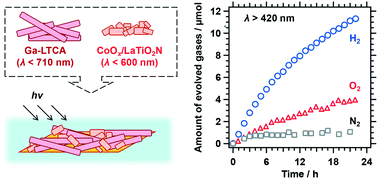Particulate photocatalyst sheets based on non-oxide semiconductor materials for water splitting under visible light irradiation†
Abstract
Particulate photocatalyst sheets based on a hydrogen evolution photocatalyst (HEP) and an oxygen evolution photocatalyst (OEP) embedded in a conductive material can realize efficient and scalable water splitting. However, existing sheet systems involve photocatalytic materials with absorption edge wavelengths (λabs) of approximately 500 nm. Thus, the development of sheet systems based solely on photocatalysts with longer absorption edge wavelengths is essential for obtaining solar-to-hydrogen energy conversion efficiency required for practical applications. In this study, we present a photocatalyst sheet system based on Ga-doped La5Ti2Cu0.9Ag0.1S5O7 (Ga-LTCA, λabs = 710 nm) as the HEP and LaTiO2N (λabs = 600 nm) loaded with cobalt oxide (CoOx) as the OEP, both embedded in a Au layer by particle transfer (Ga-LTCA/Au/LaTiO2N). Ga-LTCA/Au/LaTiO2N sheets modified with Rh species evolved hydrogen and oxygen simultaneously under visible light irradiation (λ > 420 nm). The loading of CoOx onto LaTiO2N was found to be essential for successful water splitting, as was the choice of pH values during water splitting. The roles of CoOx and other factors in determining the water splitting activity of the Ga-LTCA/Au/LaTiO2N sheets are described herein, based on the photoelectrochemical properties of LaTiO2N photoanodes.



 Please wait while we load your content...
Please wait while we load your content...